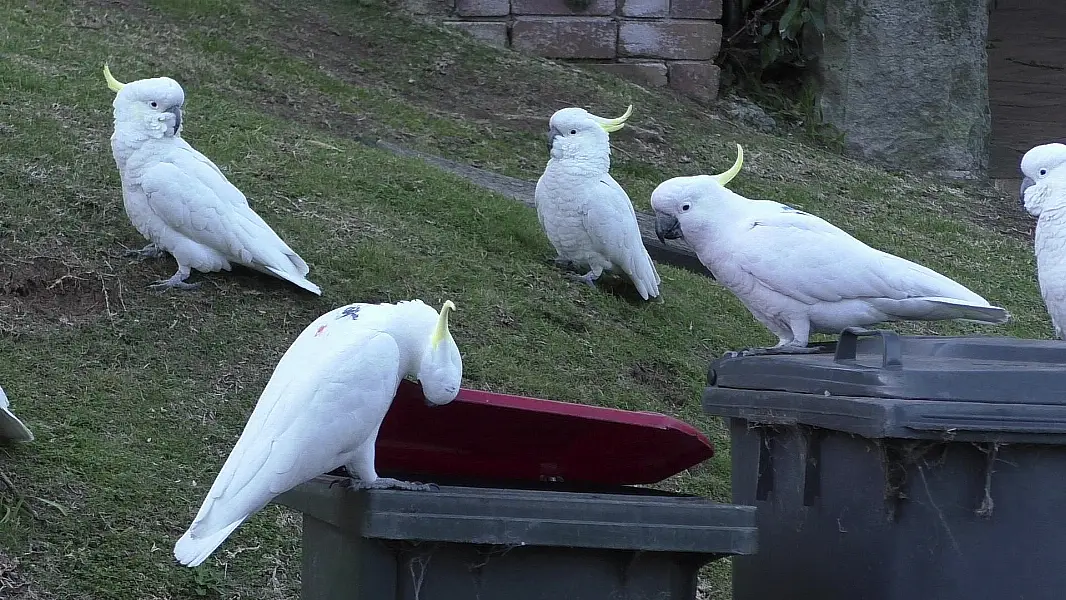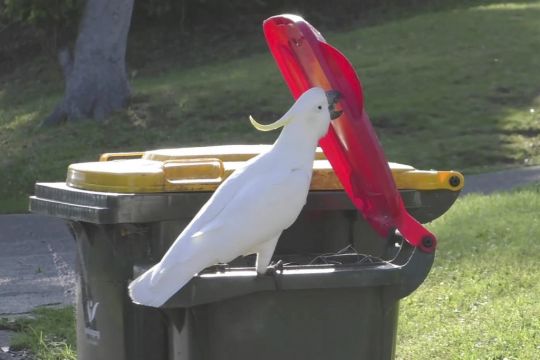Australian sulphur-crested cockatoos have learned to open bins – and the technique is catching on, as other members of the species learn how to do it in the same way humans might learn a dance move.
Researchers documented the technique in three suburbs of Sydney in early 2018, and found that it had spread to 44 suburbs by late 2019.
Scientists analysing videos of 160 wily birds lifting bin lids as well as the geographic spread of the skill concluded that most birds learned by watching others.
The cockatoos’ knack for social learning may be one of the traits that allow them to thrive in unpredictable or human-dominated environments, according to research published in the journal Science.
The research came after Sydney ornithologist Richard Major noticed a sulphur-crested cockatoo opening his bin a number of years ago.

While not every resident would be thrilled by this development, Mr Major was impressed by the bird’s ingenuity.
It is quite a feat for a bird to grasp a bin lid with its beak, pry it open, then shuffle far enough along the bin’s edge that the lid falls backwards – revealing edible treasures inside.
Intrigued, Mr Major teamed up with researchers in Germany to study how many cockatoos had learned this trick.
In early 2018, they found from a survey of residents that birds in three Sydney suburbs had mastered the novel foraging technique. By the end of 2019, birds were lifting bins in 44 suburbs.
Mr Major, who is based at the Australian Museum, said: “From three suburbs to 44 in two years is a pretty rapid spread.”
The researchers’ next question was whether the cockatoos had each worked out how to do this alone – or whether they copied the strategy from experienced birds. They discovered that the birds had indeed learned the trick by watching their peers.
“That spread wasn’t just popping up randomly. It started in southern suburbs and radiated outwards,” said Mr Major. In effect, it caught on like a hot dance move.
Scientists have documented other examples of social learning in birds. One classic case involves small birds called blue tits that learned to puncture foil lids of milk bottles in the United Kingdom starting in the 1920s – a crafty move, though less complex and physically demanding than opening bins.

Lucy Aplin, a cognitive ecologist at Max Planck Institute of Animal Behaviour in Germany and co-author of the study, said real-time observations of a new “cultural trend” spreading in the wild – or suburbs, in this case – afforded the cockatoo researchers a special opportunity.
“This is a scientist’s dream,” she said.
During summer of 2019, bin collection day in suburban Sydney doubled as the team’s research day. As bin lorries rolled down their routes and people rolled their waste onto the kerb, expert Barbara Klump stopped to record cockatoos landing on bins.
Not all cockatoos succeeded in opening them, but she took around 160 videos of victorious efforts.
Analysing the footage, Ms Klump, also from the Max Planck Institute, realised the vast majority of birds opening bins were males, which tend to be larger than females.
The birds that mastered the trick also tended to be dominant in social hierarchies.
“This suggests that if you’re more socially connected, you have more opportunities to observe and acquire new behaviour – and also to spread it,” Ms Klump said.
Cockatoos are extremely gregarious birds that forage in small groups, roost in large ones, and are rarely seen alone in Sydney.
While many animals have declined with the expansion of Australian cities, these bold and flamboyant birds have generally thrived.
“In an unpredictable, rapidly changing environment with unpredictable food sources, opportunistic animals thrive,” said Isabelle Laumer, a behavioural researcher at the University of California, Los Angeles, who was not involved in the research.
Over the past decade, research has shown that “urban adaptability is correlated with traits like innovativeness, behavioural flexibility and exploration,” said Ms Aplin.
What the new research adds to that understanding is that creatures that easily transmit knowledge and new skills socially also have an advantage.







